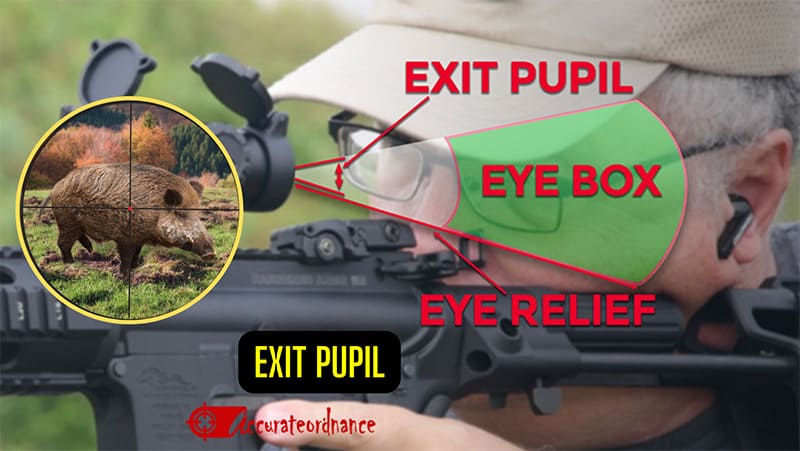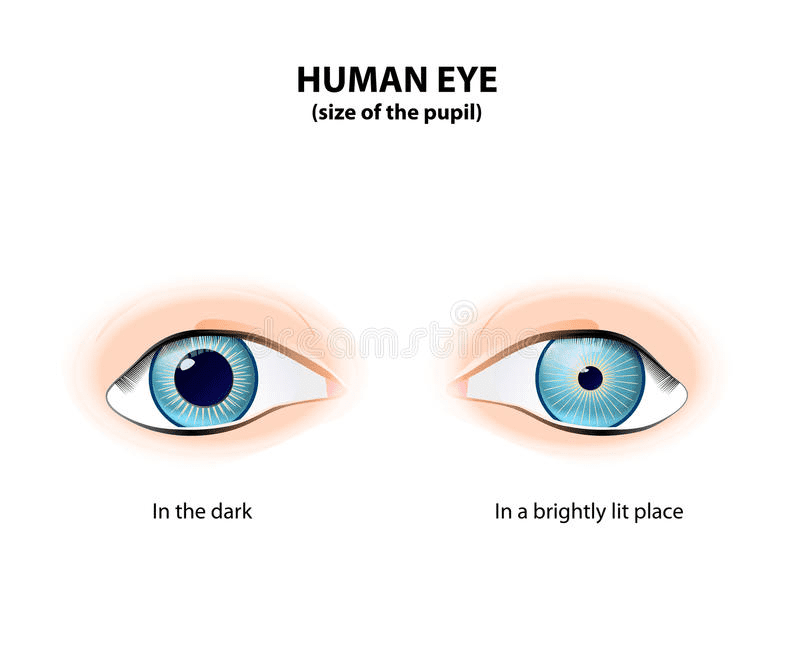Most hunters and marksmen are familiar with the concept of light gathering. They understand how important it is to have a scope that has a bigger main tube diameter. A scope with a larger tube would likely increase the quantity of light transmitted through that scope, thereby allowing the scope to produce a brighter target image.
A bright target image is very important for shooters because it helps them achieve more precise and accurate shots, especially when the environment does not have enough natural ambient light.
It is, however, unfortunately, that many of these shooters who understand the fundamental principle of light gathering do not completely understand the function of the exit pupil in a scope.

The main objective of this article is not to overwhelm you with all the jargon associated with an exit pupil or dig deep into the scientific explanations and principles since doing so would bore you. We would look at this subject in the simplest way possible with easy-to-understand examples.
Why Should I Know About Exit Pupil?
Most shooters, like myself, prefer to focus our attention on the more thrilling parts of precision shooting or hunting. However, in order to improve our marksmanship and become more efficient in the sport, we must have a basic understanding of such topics. That being said, let’s go to the core of exit pupil to better grasp how crucial this phrase is to your shooting.
Knowing the value of the exit pupil of a scope you want to use will help you in several ways. Understanding the exit pupil when purchasing a new spotting scope, riflescope, binoculars, or even a rangefinder can help you make an informed decision on the one you should purchase. Knowing the magnification level that gives the optimum light-gathering abilities might be critical in your decision-making if you’re using a variable magnification scope.
What is an Exit Pupil?
An exit pupil is the size or diameter of light that leaves an optical instrument. We all know that a riflescope has two major glasses on the outside. The objective lens is closer to the target and it is from this lens that light from the target enters the scope. The second lens is the ocular lens or eyepiece, and it is the lens closest to the shooter’s eyes.
When a shooter wants to look through a scope, he views it from the ocular lens. In other words, light that has passed through the length of the scope tube will exit the tube from the ocular lens where the shooter’s eye is waiting to receive the image. The diameter of this exiting light is what is called the exit pupil diameter.
Minimum and Maximum Exit Pupil
If the optical device has a single or fixed magnification, then the diameter of the exit pupil will remain constant. However, if the optical device has a variable magnification, then the exit pupil will have a minimum and maximum value, which will change with respect to the magnification.

In this diagram, we have an 8×20 optic, the exit pupil of the optic is 2.5mm, and it is smaller than the human pupil, which is 7mm. With this scenario in low light settings, you will perceive the images as dark.

With this 7×50 optic, the human pupil is almost the same size with the optics’ exit pupil. Therefore you will perceive the images as bright.
Both illustrations were carried out in low light condition.
How Exit Pupil Works
The easiest way to explain the concept of an exit pupil is by using a simple example. If you have a riflescope with you already, try to hold it out in front of you at arm’s length and point it towards a source of light. After doing this, you will observe that the light view through the lens seems to be lesser or smaller when compared to the eyepiece’s entire surface area.
In simple terms, it means that you would see a smaller light diameter coming out from the lens (normally, you’d have expected the total surface of the lens to display the light). When you adjust the magnification of your scope to the highest, the light will be smaller, meaning the exit pupil is smaller at higher magnification. And when you zoom out or adjust the magnification to the lowest, the diameter of light coming from the lens will increase, meaning a bigger exit pupil.
So the question now is, is a bigger exit pupil better? Well, not really. This is because the exit pupil of the scope must match the eye pupil.
Usually, the diameter of the exit pupil should match the size of your eye pupil. When this happens, the target image will be as bright as possible. In other words, when these two diameters are far from each other, the light-gathering capacity will be lessened, making it more difficult to distinguish details when natural light is sparse.
What is the Optimal Eye Pupil
You’re probably asking how you’d know what the pupil diameter of your eye is or how you’d measure it. This is very simple. The eye pupil diameter of most teenagers or young adults usually expands or dilates to approximately 7mm. As we get older, that size steadily decreases, finally reaching the lowest limit of around 5mm in most cases. As a result, 5mm is widely acknowledged as the benchmark against which most optical performances are measured.

We used a riflescope to demonstrate the theory underlying exit pupil, but the same approach would apply to spotting scopes, binoculars, and other optical instruments. Having known that the optimal exit pupil diameter is pegged at a value of 5mm, a smart shooter can use it as the standard against which to evaluate new optical equipment.
When natural light fades in the outback, this same 5mm, exit pupil standard may be used to determine the ideal magnification level when choosing a variable magnification scope.
Even little deviations from the recommended standard might result in a major visual impairment. That is because a lens’s light-gathering capacity is proportional to the square of that value. This means that an optical device with an exit pupil of 5 mm would give 4 times the light-gathering abilities of a 2.5 mm exit pupil lens.
Why Exit Pupil is now indicated in scopes
Before now, you would hardly hear anyone make mention of the phrase exit pupil when considering a scope. That is because most shooters were ignorant of the concept. It appears that most manufacturers have just recently started including exit pupil values in the product specifications sections.
It is comparable to how certain ammunition and bullet makers have previously refused to reveal the ballistic coefficient of their projectiles. However, when customers became more aware of the critical relevance of such features, those details became more available.
How To Calculate Exit Pupil Diameter

Unlike the ballistic coefficient of a bullet, which is difficult to estimate, finding the exit pupil of a riflescope is quite simple. Basic mathematical knowledge will help you get the task done with minimal effort. All you have to do is check or measure the objective diameter (millimeters) of the scope and divide it by the scope’s magnification.
As a formula, it would be as follows:
Exit pupil = (objective diameter ) divided by (magnification).
Suppose we apply this approach to get the ideal low light setting for a Leupold 4.5-14x56mm scope. In that case, we may start by calculating the value at the highest magnification setting, which would be: (56mm objective lens diameter divided by 14x magnification) which equals an exit pupil of 4mm.
In this scenario, it seems natural to think that a lower magnification level of 11x would be more acceptable when things look a bit dim. We’d have (56mm divided by 11x) which would result in a 5.09mm exit pupil, which is closer to the standard figure of 5mm.
The ideal magnification in low-light settings might vary greatly in several scenarios. For instance, if we used the same formula is used for a Vortex 3-15x42mm riflescope under the same conditions, we would discover that the ideal magnification for this riflescope would be around 8.4x power.
The 42mm objective lens diameter was primarily responsible for the variance in this situation. That isn’t a bad thing because it only shows that the shooter should be educated about exit pupil and the function it plays and then make use of that information to their advantage.
In the last example, I used a quick method to calculate the exit pupil so I could quickly have an idea of the optimal magnification for low light setting. The quick method involved using the 5mm standard exit pupil to divide the objective lens diameter of 42mm (that was how we got 8.4x). This quick computation would help a buyer determine which of the two scopes to get for his shooting application.
If you use the same approach for binoculars, you will discover that both the 7x35mm and 10x50mm versions perfectly meet the value of 5mm.
Quality always matters
The exit pupil of your scope is a very important value that you must check while shopping for a new scope. However, the quality of the scope is still important. Suppose we compare two riflescopes, both with the same exit pupil. You will notice that the scope with a better lens quality will produce brighter images because a quality lens will always allow more light into the scope.
Benefits of a Large Exit Pupil
A Large exit pupil has several benefits that go beyond merely filling the eyes of the shooter with abundant light. One of the benefits of a big exit pupil in a riflescope is that the shooter will have more freedom to position his eye with regard to the optical axis. If your scope has a very small exit pupil, you may not have the luxury of positioning your eye anywhere behind the ocular lens.
As a target shooter, you may have to devote more time trying to locate the sweet spot of, let’s say, a 2mm exit pupil or smaller when you should have sighted the weapon quickly for the quick shot. In the end, you’ll be happy to have a larger exit pupil because it will provide you with a clear view of what you need to see, even when your eye isn’t in the best of places.
Another advantage of a sufficiently large exit pupil is the capacity to perceive the scene clearly and without straining the eyes. When comparing two scopes of comparable optical quality, the one that has the bigger exit pupil is likely to be preferred. Both will provide the same imagery, but one will require less effort from your eye.

Mike Hardesty is a published freelance gun writer. He also possesses specialized expertise in rifle scopes With dozens of articles and reviews published in Pew Pew Tactical, Snipercountry.com, and TTAG (The Truth About Guns), Mike is considered a firearms expert. His special area of expertise is handguns.
Mike is a long-time shooter. He has been punching paper targets, taking deer and other game and shooting at competitions since about 1975. Other related pursuits include reloading and bullet casting. He currently reloads for over 10 calibers, both handgun and rifle. His reloads, particularly for 9mm, were in great demand during the height of the ammo shortage among family and friends. He donated hundreds of rounds to informal shooting sessions. He was quoted as saying “I do not sell my reloads but I sure will help my guys shoot ’em for free!”. He has a few cherished firearms that he has inherited or otherwise procured — those are his favorites.
He earned B.S. and M.S. degrees from Indiana State University in 1974-1975.
He’s a firearm experts and is the founder of mhardesty.com.
